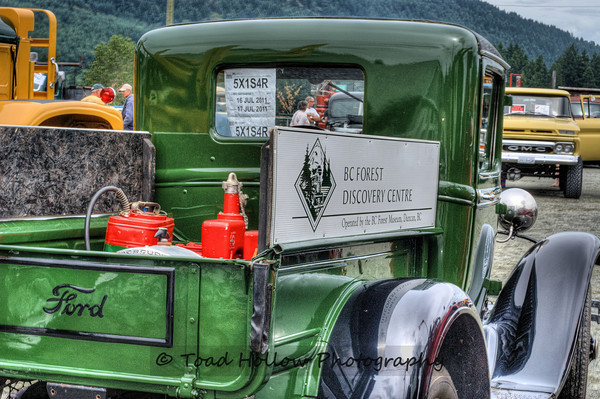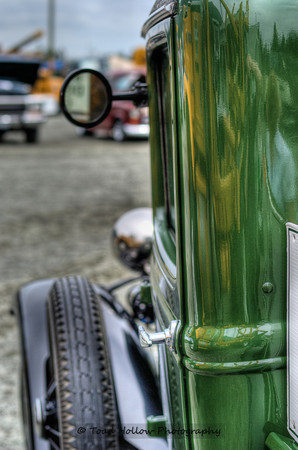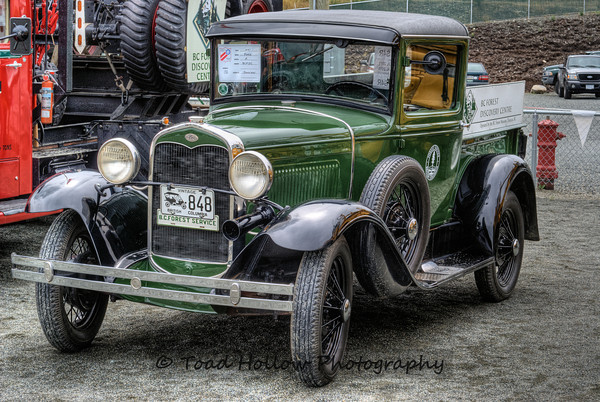Toad Hollow Photography is a Canadian based photography company that specializes in Canadian landscapes and architecture photography using HDR, focusing on historic and heritage based subjects. Using this fine art photography as the basis for their daily blog, Toad Hollow Photography shares an often whimsical view of Canada through their lens.
Check out the Toad’s photoblog and gallery of Canadian Landscape Prints.
Introduction
I have loved imagery my entire life, both personally and professionally. You can ask my wife, a bad picture on the TV will drive me absolutely batty. So, as things have progressed I suddenly found myself in possession of my dad’s beloved DSLR camera after he passed away, and with a purpose in my heart I set out on this adventure we now refer to as Toad Hollow Photography.
I have a lengthy background in software development and engineering labs, and was an early adopter of digital photography. The original cameras we used were all the point and shoot types, with a maximum resolution of 640×480. The picture quality was terrible. But, it was a digital.
I wanted a digital SLR camera. When they finally hit the market, I knew it would only be short while before I was immersed. After acquiring my dad’s camera, the learning began in earnest. I quickly realized there was something that I wasn’t happy with in terms of my work; the dynamic range wasn’t quite enough to fully express what I was seeing as I took the picture. It took only a little research to find the ultimate solution in HDR (High Dynamic Range) photography.
The premise is that the photographer takes multiple photographs of varying exposure value for each image being created. You then take those multiple exposures and via some specialized software, of which there are quite a few choices, and merge them. Advanced HDR applications also include the ability to perform in-depth tone-mapping, which is a technique that when used correctly can produce images that are some of the most compelling and dramatic I have seen, with full dynamic range. It can also be used to produce “painterly” or “over the top” type of images that appeal to a different group, but as with all techniques and tools, there most certainly is a following.

My Fundamentals
I have been asked by several of our friends here to discuss a little about how I go about creating our imagery at Toad Hollow Photography. To maintain our consistent style, I have developed a series of fundamentals that I nearly always follow.
- Always use aperture priority mode.
- Always utilize the lowest ISO possible to reduce noise.
- Any errors introduced into the work-chain will always run the entire path from the point of introduction.
- Reduce or eliminate errors by recognizing common or frequent ones and become cognisant during the workflow.
- Perform as much of the “heavy lifting” as possible in the HDR merge/tone-mapping application. We use Photomatix Pro.
We can now begin to expound on the above points.
Aperture Priority Mode
Most modern DSLR cameras give the photographer the ability to select several different “priority” modes. In the holy trinity of camera settings, being ISO, shutter speed and aperture setting (f/stop), if you select aperture priority mode it allows you to specify the f/stop and ISO, and the built in light meter will automatically select the correct shutter speed for you. If you are in shutter priority mode, you would select ISO and shutter speed, and the built in meter would automatically set the f/stop for you.
I always use aperture priority. The reason for this is it will create the most crisp and detailed merge possible as each frame, referred to as brackets, will be the identical focus and depth of focus. If you were to go with shutter priority, each bracket would have a different f/stop and thus a different depth of focus. This makes for much less clarity in the final merged result.

From here for me, the tricky part is selecting the right f/stop and ISO setting to achieve the result I am going for. I find that sometimes I have to increase the ISO to get faster shutter speeds to avoid motion blur. For the style of photography that we do, moving objects like birds and foliage are our biggest nemesis. I tend to shake my fist at the wind.
Lowest ISO
I always try to use the lowest ISO I possibly can to reduce noise and produce better quality results. The more noise that is evident in the source files, the more noise you’ll have in your output. But, as mentioned before, motion is the hardest thing to compensate for with our style of imagery, and therefore we sometimes have to forgo using 100 ISO to offset external lighting and movement issues.
Errors In The Chain
Any time an error is introduced into the work-chain, that error follows forward to the end of the chain; your final result. This really drives us to be as accurate and careful through each step of the process to avoid or at least vastly reduce these errors.
For example, if I didn’t properly tune my settings during the image capture process and wind caused massive blur in the trees in my picture due to a slow shutter speed, I cannot correct that. This error will follow through to the bitter end. These images never make it “live” and end up archived on my long term storage never to be seen again.
Taking this concept further, if during the merge and tone-mapping step I blow out my whites on the histogram, those details are lost forever and cannot be corrected. What this all comes down to is by the time I am finalizing my image in Photomatix to bring into my final post-processing software, it contains no major errors and has all the dynamic range I want… it just needs some tweaking to really bring it to life.
Reduce or Eliminate Common Mistakes
As I was going through (and continue to) my learning process, I started to notice common mistakes I was making that resulted in sub-standard image quality. At this point I became aware of these issues and started to look for them before they were introduced into the work-chain. I can honestly say that our percentage of internet ready images shot up when I started to do this. You may believe this to be common sense, and I can`t really disagree, but it`s so important I felt it merited discussion.
Heavy Lifting in the Merge
I try to do as much heavy lifting as possible in the merge process. When the image is loaded into my final post-processing software, no whites or blacks can be blown out, no ghosts can remain, no color banding can exist; these are things that cannot be remedied.
There are many settings, in Photomatix Pro these are represented as sliders, that the photographer can adjust in the tone-mapping phase. This is a critical phase of image creation. I have several sliders that almost always remain the same, and several that need to be manually adjusted for each image processed. I cannot use batch processing, I must merge and tone-map each picture individually. This is where the personal style comes into play. Once I identified what I was trying to do with my HDR work, it became a matter of finding those settings that produced these results.
From this point, the final merged and tone-mapped image is saved as a TIFF file and brought into my final phase post-production software. I only typically perform the following actions in this software, in this order:
- Remove any blemishes in the sky, usually perfect, tiny little circles that are darker than their surroundings.
- Adjust brightness and contrast, color saturation, and sharpness.
- Apply a minor filter that tends to shift the tone scale ever so slightly to a darker tone; I find this accentuates the light and shadow regions in our photos providing a better looking end result.
- Apply a high pass sharpen filter to accentuate the details, using a very low threshold setting to avoid over-sharpening.
That`s it. We have our final image.

I’d be happy to go into further details on any of the points mentioned, please feel free to ask any questions you may have and depending on feedback, I could do a follow-up for everyone.





28 Comments
I still think it requires a special ‘Toad’ touch, that bit of majic that can only be performed if you have a horny skin, bug eyes and drive a red converable – accompanied by the beautiful Mrs Toad, of course.
Never-the-less, I’ll keep it in mind.
You’re a bloody genius, Scotty.
Wow, I don’t even know how to being to thank you for your kind words here Tom!!! And coming from you… this means so much. Mrs. Toad is sitting beside me here, and rest assured you brought a huge, warm smile to her gorgeous face. You’re a top drawer friend and all-’round fine gentleman, sir.
The best article I have seen on HDR :-D, gives vitaL points that often are missing in tutorials.
We cannot thank you enough for all your kindness, my friend! That means so very much, thank you!!
Always use aperture mode? No, only use aperture mode when you can’t use manual.
Thank you for taking the time to read our post here and for sharing your comments with us, we really do appreciate it. Of course, for each photographer, we have different ways of producing our work and these nuances all make up our personal artistic touch. For us, aperture priority is key in how we produce our work, for you, you may find other and better methods that produce the end results you are after.
The most important statement here — “Any time an error is introduced into the work-chain, that error follows forward to the end of the chain; your final result.”
I’m glad you have found a process that works for you. Thanks for the post.
Thank you for taking the time to read our article, and for the great comments Libby!! We really do appreciate that!
Really impressed with this article, but behind all the tech one fundimental necessity – ‘Once I identified what I was trying to do with my HDR work………….’
You clearly seem to have found a personal approach to HDR. Well done.
Gosh, thanks Richard, what a kind thing to say! You made my whole day, my friend! We really appreciate you taking the time to read this post and for these just wonderful comments!
I love your images and your HDR treatment. I am a huge fan of the look whereby I can easily convince myself that the image in front of me is a much truer rendition of what your eyes saw than a version produced by a camera. I also love midday shots that capture brightness and vivid colours. Of course I’d love to know what settings you do use in Photomatix Pro to achieve this.
Thank you SO much, Rick, that’s awfully kind of you! I really appreciate the visit and the comments and question you pose. As a matter of fact, I am in process of writing a part II to this article, and your question here will be the first one addressed in it. It should be ready in a manner of days. And again, many thanks for taking the time to stop by!!
Wonderful tips. I have one problem with my HDR images that I don’t know how to eliminate – edge glow. Do you have any advice for eliminating that problem? I also use Photomatix Pro 3.
Thanks, Al, great question here!! I don’t really have a magic bullet for that problem, but will get a little more in-depth about this in our next installment, thanks for posing the question. We really appreciate you taking the time here, Al, thank you!
I eliminate or minimize glow by Trey Ratcliff’s method: Bring the tone mapped image plus the images that created the tone mapped image into Photoshop. Fix glows, skies, etc by layer masking using the brush tool with different opacities.
Excellent writeup Toad! Very thorough explanation of the HDR process. Thank you for sharing.
Thank you, Michael, we really appreciate your support & kindness! Thanks for taking the time, my friend.
What are some examples of your “common mistakes” you mention above?
Excellent question, thank you Gregg!! This will definitely be a key point for our follow-up article, thanks for asking. And many thanks for taking the time to read and respond, it really means a lot!
Awesome article Toad. Thank you for your insight and for familiarizing me with a medium I’m not so familiar with.
All my pleasure and honor Chase, thank you so much for taking the time to read and comment here! I really appreciate that a lot! Looking forward to sharing more in the future!
Thank you for the support!
Good evening
Thank you for sharing your HDR photo processing. You explained the process very well, along with the problems one might have. As I have said before your photos are truly a work of art. Question, are the mirror filters in Photomatix or another software.
Thank you again
Maurice
Hi Maurice, thanks for taking the time to pop by and read our latest submission here, we really appreciate it! We are working on a follow-up article to answer some of the questions posed in this original thread here, and I hope to answer your question. I believe you are asking about the “minor filter” I have mentioned above? I’d be happy to expound on that in our next article. If this wasn’t what you were hoping for, please just give me a little more detail so I can be sure to address your questions?
i agree with the comment that this article overstates the importance of using aperture priority mode. Clearly you know your way around a camera and your HDR photos are among the most realistic (while still having that color “pop” that everyone loves) I’ve seen. When merging multiple images for HDR, the aperture is the most important thing to remain constant, true, but that does not necessarily mean one should “always” use aperture priority? Manual shooting mode allows one to keep the aperture consistent between shots while also giving control over all other aspects.
Thank you Evan! I totally hear your point here and agree about having finer control. I hope to make clear that this is how we do our photography, this may or may not work or be optimal for everyone. I tend to move VERY fast during a shoot, so being able to set my aperture as priority allows me to move from scene to scene very quickly. You may find other techniques that work better for you and we encourage everyone to explore their own techniques. This article was just meant as a primer to explain how we work, as we were getting tons of questions about that. As you stated, and I wholeheartedly agree, maintaining a constant aperture is key… exactly how the photographer goes about doing that is a personal exercise.
Thanks for your sharing. You mentioned that you leave several of the sliders in Photomatix alone and don’t ever change them. Could you share those settings with us or has this already been shared in another post?
At last someone that makes realistic HDR images. Your approach is refreshing in these days of over colored sunsets, etc,